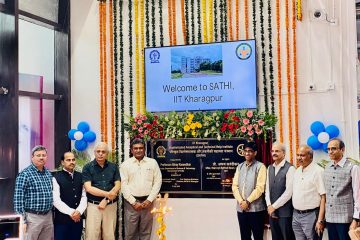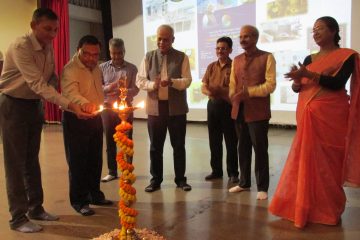Hearing the word crystals, people commonly recognize it to be a shiny material associated with a part of jewellery considering their shapes of flat faces with sharp angles. In actuality, crystalline materials have a much wider range of applications, for example in laser technology, optics, high-energy physics, biomedical technology and light-emitting diodes. Each area of application requires a specific type of material. New crystalline materials are constantly being tested to determine whether they have the desired properties. A crystal is scientifically defined by its microscopic atomic arrangement, not its macroscopic shape. Its crystallographic forms are sets of possible faces of the crystal that are related by one of the symmetries of the crystal. For example, crystals of galena often take the shape of cubes, and the six faces of the cube belong to a crystallographic form that displays one of the symmetries of the isometric crystal system. The visible external shape of a crystal is determined by its structure, the specific crystal chemistry, bonding and the conditions under which the crystal formed. The symmetry of crystal is constrained by the requirement that the unit cells stack perfectly with no gaps. There are 219 possible crystal symmetries called crystallographic space groups.
Until now, crystalline materials have been difficult to test on a large scale and to find suitable materials. Determining the electronic, magnetic and elastic properties of a crystal is often time-consuming, expensive and calculation-intensive as it requires extensive experimentation.
To solve both the problem of costly experiments and of computing-intensive theoretical estimation, researchers at IIT Kharagpur in collaboration with the Indo-Korea Science and Technology Center (IKST) have now developed a method called CrysXPP to predict the properties of crystalline materials through machine learning as a popular alternative. Machine learning algorithms are data-intensive. It involves a large amount of data from the source materials which are labelled with property labels to accurately predict properties of new crystals. With these shortcomings in mind, CrysXPP was developed, as a machine learning system that enables rapid prediction of various material properties with high precision.
 Professor Niloy Ganguly
Professor Niloy Ganguly
Computer Science & Engineering
IIT Kharagpur
Prof Niloy Ganguly, Computer Science and Engineering, IIT Kharagpur and Visiting Professor at L3S Research Centre, Germany stated that, “The published work addresses the important problem of sparse and opaque data, which are the main obstacles in predicting the properties of crystals quickly and accurately.”
While property-laden data is scarce, the simple structural information of crystals is abundant. CrysXPP takes advantage of this because the individual atoms and their interconnections in the crystal structure are also responsible for the specific properties of the crystal. IIT KGP Chronicle entails into a generic chat with Associate Professor Pawan Goyal, Computer Science and Engineering, IIT Kharagpur and fellow researcher of this study to expedite their findings.
 Prof Pawan Goyal, Associate Professor
Prof Pawan Goyal, Associate Professor
Computer Science & Engineering
IIT Kharagpur
Q. What is the aim of this research? Can you elaborate on the general impact of AI and deep learning on Computational Material Science?
Crystalline materials have a wide range of applications, for example in laser technology, optics, high-energy physics, biomedical technology or light-emitting diodes. Each area of application requires a specific type of crystalline material. New crystalline materials are constantly being tested to determine whether they have the desired properties.
Ascertaining a crystal’s properties, such as the Electronic Band Gap, Formation Energy, Magnetic Moments and so on, is often time-consuming and expensive because it necessitates extensive experimentation. Therefore, such a process is not scalable when one desires to scan through thousands of crystals to determine the most desirable crystal material suitable for a particular task. A second-best method is, instead of doing explicit experimentation, the properties are calculated with reasonable accuracy through a theoretical manner such as Density Functional Theory popularly known as DFT. However, this process is computationally heavy. To tackle both the problems of costly experimentation and theoretical estimation via heavy simulations, Machine Learning (ML) methods are increasingly becoming a popular alternative. Machine Learning methods are fast and do not involve costly calculations. But the problem with machine learning algorithms are, they are data intensive that require to be trained with a large amount of property-tagged data of stock materials to make accurate property predictions of new crystals. Such property-tagged data is not available sufficiently. Moreover, whatever is available is not experimentally derived property rather theoretically (DFT) calculated, hence training with theoretically derived data can lead to biases and inaccuracies within the system.
To overcome these limitations, researchers at IIT Kharagpur and Indo-Korea Science and Technology Centre (IKST), Bangalore have proposed CrysXPP, a new method to predict the properties of crystalline materials through machine learning. The result was recently published in the NPJ Computational Materials, a journal of the prestigious Nature Publishing Group.
https://www.nature.com/articles/s41524-022-00716-8
Q. What significant impact has been created by this research and further what is expected out of it?
CrysXPP is a machine learning (deep-learning) framework which allows rapid prediction of different properties of materials with high precision. We know that while property-tagged data is sparse, the simple structural information of the crystals is available in abundance. Also the atomic properties of each atom in the crystal and their interconnection in the crystal structure, are responsible for specific properties of the crystal. CrysXPP converts such crystal 3D structure information into 2D graphs and initially learns their structural properties. Then it is trained with the small amount of property-tagged available data. The two-stage training successfully helps in circumventing the problem of the sparsity of property-tagged data, the first stage helps in capturing all their important structural and chemical information and due to this only a small amount of tagged data for property prediction becomes good enough to give an accurate prediction. The performance even overcomes the hindrance of being trained with datasets that have some inaccuracies due to limitations of DFT.
Another important shortcoming of ML models in general is interpretability, it generally fails in providing reasons behind the manifestation of certain crystalline properties, thus making its usage unattractive and unconvincing to practitioners. CrysXPP incorporates a feature selector in its design which acts as a switch pinpointing the exact features of the constituent atoms responsible behind the crystal expressing a particular (range of value) property.
To summarize it, this paper published in the prestigious nature-group journal addresses the important problem of data sparsity and opaqueness which are the main obstacles in predicting the properties of crystals quickly and accurately.
Q. What is the future of this study? What are your other major projects at present?
At the core of the innovation, there is a deep-learning based autoencoder to incorporate the structural information of a lot of materials, which can transfer knowledge to an explainable property predictor. We are planning to undertake a larger-scale study using more materials. We are also planning to use the predictor as a reward function to accelerate the generation of new materials.
Contact: Niloy Ganguli, Professor, Computer Science; Email – niloy@cse.iitkgp.ac.in & Prof. Pawan Goyal, Associate Professor, Computer Science & Engineering; Email – pawang@cse.iitkgp.ac.in
Content Writer:- Poulami Mondal, Digital & Creative Media Executive (Creative Writer)
Email: poulami.mondal@iitkgp.ac.in, media@iitkgp.ac.in, Ph. No.: +91-3222-282007
Follow us: Facebook – IIT Kharagpur; Twitter – @IITKgp; Instagram – @iit.kgp
For news visit: https://kgpchronicle.iitkgp.ac.in/



